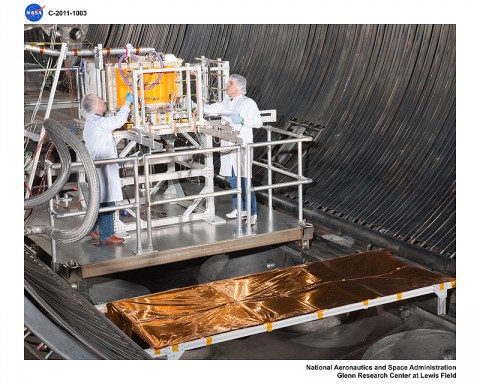Written by Priscilla Vega
NASA’s Jet Propulsion Laboratory
 Pasadena, CA – New and improved ways for future space travelers to communicate will be tested on the International Space Station. The SCaN Testbed, or Space Communications and Navigation Testbed – designed and built at NASA’s Glenn Research Center in Cleveland over the last three years. – will launch later this year from Japan, for delivery to the Space Station.
Pasadena, CA – New and improved ways for future space travelers to communicate will be tested on the International Space Station. The SCaN Testbed, or Space Communications and Navigation Testbed – designed and built at NASA’s Glenn Research Center in Cleveland over the last three years. – will launch later this year from Japan, for delivery to the Space Station.
The SCaN Testbed will provide an orbiting laboratory on the Space Station for the development of Software Defined Radio technology. Researchers will have the capability to load new software onto these devices even after they’ve launched.

The testbed will be the first space hardware to provide an experimental laboratory to demonstrate many new capabilities, including communications, networking and navigation techniques that utilize Software Defined Radio technology. The SCaN Testbed includes three such radio devices, each with different capabilities.
Two Software Defined Radios were developed under cooperative agreements with General Dynamics, West Falls Church, VA, and Harris Corp., Melbourne, FL, and the third was developed by NASA’s Jet Propulsion Laboratory Pasadena, CA. JPL also provided the five-antenna system on the exterior of the testbed, which will be used to communicate with NASA’s orbiting communications relay satellites and NASA ground stations across the United States.
These systems will allow researchers to conduct a suite of experiments over the next five years, enabling the advancement of a new generation of space communications.
“Public researchers such as students and professors or industry will have the opportunity to write software to test on the devices, which makes this testbed unique,” said Jim Lux, a JPL scientist and SCaN Testbed co-principal investigator. “The NASA/JPL radio has been developed using open source software, and most of the documentation is available to the public.”
The SCaN Testbed was developed at Glenn Research Center, which is also responsible for mission operations, with high-speed ties to NASA’s Marshall Space Flight Center, Huntsville, AL, for real-time command and telemetry interfaces with the Space Station. NASA Johnson Space Center’s White Sands Test Facility, Las Cruces, NM, and Goddard’s Wallops Flight Facility, Wallops Island, VA, will provide Space Network and Near Earth Network communications. JPL provided the radio frequency switching system that connects the five exterior antennas to the radios.
The SCaN Testbed will join other NASA network components to help build capabilities for a new generation of space communications for human exploration.
JPL is managed for NASA by the California Institute of Technology in Pasadena.
For more about the SCaN Testbed, visit: http://spaceflightsystems.grc.nasa.gov/SpaceOps/CoNNeCT/


